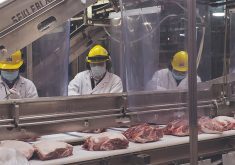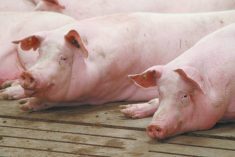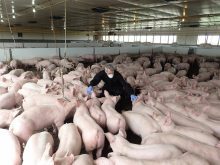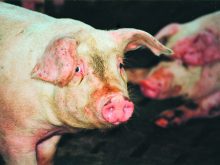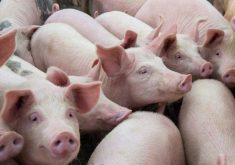Pig density, poor biosecurity and ineffective control are thought to be behind sustained waves of the disease in China
China’s hog sector is in its third wave of African swine fever primarily due to a mutated strain of the virus, says an international swine management consultant.
Todd Thurman, who owns SwineTex Consulting Services and typically spends about half his year in China, said the mutated virus is less deadly but harder to identify.
“Most of that problem has been linked to the usage of rogue, illegal vaccines that were widely used in some areas and ended up resulting in a mutated form of the virus,” he told a webinar held by meat and livestock analysts J.S. Ferraro.
Read Also

Beef check-off collection system aligns across the country
A single and aligned check-off collection system based on where producers live makes the system equal said Chad Ross, Saskatchewan Cattle Association chair.
Loss estimates over the past winter and earlier this spring ranged from about 20 percent of the herd to more than 50 percent.
He believes losses to be 30 percent.
Most of the outbreak has been in north and central China where the first wave began in summer 2018 and continued through to spring 2019. The second wave followed in late spring through to the late fall in 2019 in southern China, including in the country’s main pork producing province.
Thurman said issues of pig density and poor biosecurity, along with ineffective control, contribute to sustained waves. Some producers panicked and took their pigs to market instead of properly disposing of them.
Some farms even followed a strategy they call “pulling the tooth” in which they identified so-called sick animals and removed them but left the so-called healthy animals in their herds.
“There were a few farms that were able to at least apparently successfully execute a strategy like that but by and large it was a disaster and really ended up being a major contributor to the first two waves,” Thurman said.
During this third wave some of the issues persist. Pig density hasn’t changed much and while biosecurity has improved, there are still gaps in terms of international standards, he said.
Some analysts have reported that big producers were heavily affected while others say they weren’t. He said he believes big producers were most affected because they were most likely to use the rogue vaccines.
As the wave progresses, some things are becoming clearer. Thurman said producers kept telling them they were having a really bad year battling porcine reproductive and respiratory syndrome, or PRRS. In hindsight, it appears producers were actually dealing with the mutated ASF virus.
Chinese hog prices are down about 30 percent since January but producers are still profitable and even in record price territory.
However, he doesn’t believe the full recovery this year, predicted by the Chinese government, will happen or that the swine herd had already recovered to between 80 and 90 percent of the pre-ASF number.
“One very suspicious thing is a lot of times there was no lag between reports on expansion of the sow herd and expansion of the gross pig population,” Thurman said.
Price is the other indicator. Prices are about three times higher than pre-ASF levels, leading him to ask how that jibes with a higher supply.
In the short term, Thurman expects continued poor performance of China’s herd.
“We’re using poor quality breeding stock so most of this recovery was completed not with proper breeding stock meeting normal standards,” he said. “At this point 50 percent or more of breeding stock is not proper. We’re seeing 20-percent-plus worse reproductive performance in those animals and that’s going to be an issue to take some time to work through.”
Lower prices are likely through this summer due to normal weakening demand after Chinese New Year and the glut of pork hitting the market from some panic selling.
Finally, he said China is importing record amounts of all proteins, which also indicates the world’s largest pork consumer needs the meat.
The longer term outcome depends heavily on what happens this summer, he said. The Chinese government has defined recovery as 95 percent of the previous herd, but that still means the country would be importing five percent of its needs when it normally imports about two percent.
“While three percent difference in imports doesn’t sound like a lot, it’s very significant when you’re talking about a market the size of China,” he said.
Thurman said he believes China won’t be back to a new normal until 2024.






